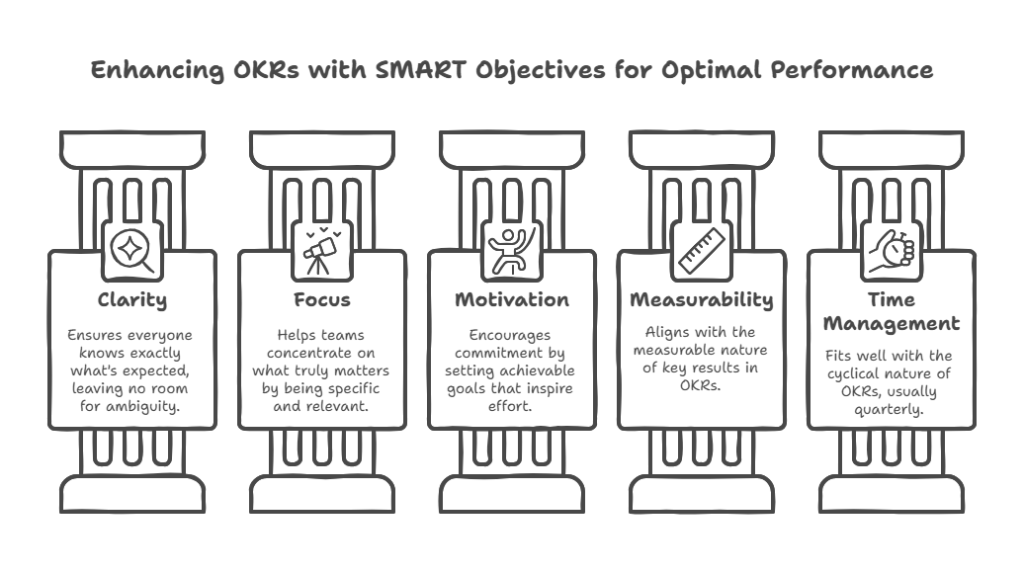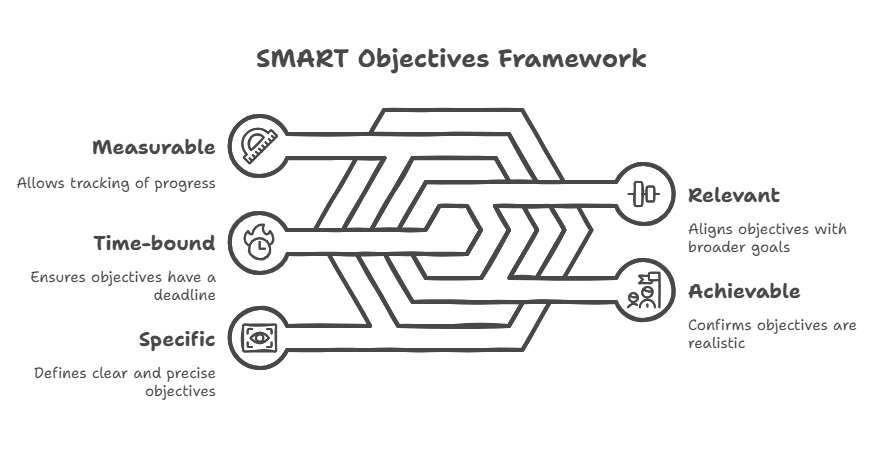Table of Contents
Introduction
Hey there, OKR aficionados! Today, we’re going to talk about a match made in goal-setting heaven: SMART objectives and OKRs. If you’ve been in the business world for more than a hot minute, you’ve probably heard of SMART goals. But have you ever wondered how they fit into the OKR framework? Well, buckle up, because we’re about to take a deep dive into the world of SMART objectives and see how they can supercharge your OKRs. Let’s get smart about getting SMART!
What Are SMART Objectives?
SMART is an acronym that stands for Specific, Measurable, Achievable, Relevant, and Time-bound. It’s a criteria used to guide the setting of objectives, making them clear and reachable. Let’s break it down:
S – Specific
Your objective should be clear and specific, not vague. It should answer the five “W” questions:
- What do I want to accomplish?
- Why is this goal important?
- Who is involved?
- Where is it located?
- Which resources or limits are involved?
M – Measurable
You need to be able to track progress and measure the outcome. Ask yourself:
- How much?
- How many?
- How will I know when it’s accomplished?
A – Achievable
Your objective should be realistic and attainable to be successful. Ask yourself:
- How can I accomplish this goal?
- How realistic is the goal, based on other constraints?
R – Relevant
This step is about ensuring that your goal matters to you and aligns with other relevant goals. Ask yourself:
- Does this seem worthwhile?
- Is this the right time?
- Does this match our other efforts/needs?
- Am I the right person to reach this goal?
T – Time-bound
Your objective should have a target date. This helps to prevent everyday tasks from taking priority over your longer-term goals. Ask yourself:
- When?
- What can I do six months from now?
- What can I do six weeks from now?
- What can I do today?
How Do SMART Objectives Fit into OKRs?
Now, you might be thinking, “This SMART stuff sounds great, but I’m all about OKRs. How do these fit together?” Great question! Let’s break it down:
SMART Objectives as the “O” in OKR
Remember, in OKR, the “O” stands for Objective. This is where SMART objectives can shine. By making your OKR objectives SMART, you’re setting yourself up for success right from the start.
Example of a SMART Objective in OKRs
Let’s say you’re a marketing manager. Here’s how a SMART objective might look in your OKRs:
“Increase our website’s organic traffic by 50% within the next quarter through content marketing and SEO optimization.”
- Specific: Increase organic traffic through content marketing and SEO
- Measurable: 50% increase
- Achievable: Assuming your current traffic and resources, this could be achievable
- Relevant: Aligns with overall marketing and business growth goals
- Time-bound: Within the next quarter
SMART Key Results
While we typically focus on making objectives SMART, the same principles can apply to your key results. In fact, the “M” (Measurable) in SMART is crucial for effective key results.
The Benefits of Using SMART Objectives in OKRs
- Clarity: SMART objectives leave no room for ambiguity. Everyone knows exactly what’s expected.
- Focus: By being specific and relevant, SMART objectives help teams stay focused on what really matters.
- Motivation: Achievable goals are motivating. People are more likely to commit to objectives they believe they can achieve.
- Measurability: The “M” in SMART aligns perfectly with the measurable nature of key results in OKRs.
- Time Management: The time-bound aspect of SMART objectives fits well with the cyclical nature of OKRs (usually quarterly).

Potential Pitfalls to Watch Out For
While SMART objectives are great, they’re not without their challenges:
- Over-complication: Sometimes, in an attempt to make objectives SMART, we can overcomplicate them. Keep it simple!
- Lack of Ambition: The “Achievable” in SMART can sometimes lead to setting goals that are too easy. Remember, OKRs are meant to be ambitious!
- Inflexibility: The world changes fast. Make sure your SMART objectives can adapt when needed.
Conclusion
And there you have it, folks! SMART objectives and OKRs are like peanut butter and jelly – great on their own, but even better together. By incorporating SMART criteria into your OKRs, you’re setting yourself up for clearer, more focused, and more achievable goals.
Remember, the key is to find the right balance. Use SMART to make your objectives clear and measurable, but don’t let it stifle your ambition or creativity. After all, some of the best innovations come from reaching for seemingly impossible goals!
Key Takeaways:
- SMART stands for Specific, Measurable, Achievable, Relevant, and Time-bound
- SMART objectives can be used as the “O” in OKRs
- Using SMART criteria can make your OKRs clearer, more focused, and more motivating
- Be careful not to overcomplicate or limit your ambition when making objectives SMART
- The “Measurable” aspect of SMART is particularly crucial for key results in OKRs
Now go forth and set some SMART OKRs!
FAQs
- Can all OKR objectives be SMART?
While it’s beneficial to apply SMART criteria to OKR objectives, some visionary or inspirational objectives might not fit perfectly into the SMART framework. The key is to find a balance. - How often should I review my SMART objectives in OKRs?
Just like regular OKRs, SMART objectives should be reviewed regularly – typically on a weekly or bi-weekly basis, with a more comprehensive review at the end of each OKR cycle (usually quarterly). - What’s the difference between a SMART objective and a Key Result in OKRs?
A SMART objective is the overarching goal (the “O” in OKR), while Key Results are the specific, measurable outcomes that indicate progress towards that objective. - Can SMART objectives be used for personal OKRs as well?
Absolutely! SMART criteria can be applied to any type of goal-setting, including personal OKRs. - How do I make sure my SMART objectives are ambitious enough for OKRs?
While the “A” in SMART stands for “Achievable,” in OKRs, it’s okay to set ambitious, stretch goals. Aim for objectives that are challenging but not impossible.
Further Reading
- “Measure What Matters” by John Doerr
- “Introduction to OKR” by Felipe Castro: https://felipecastro.com/en/okr/what-is-okr/
- “SMART Goals: How to Make Your Goals Achievable” by Mind Tools: https://www.mindtools.com/pages/article/smart-goals.htm
- “The Art of Setting Smart Goals” by Hussein Akrach: https://www.forbes.com/sites/forbescoachescouncil/2018/05/08/the-art-of-setting-smart-goals/
- “OKR: Objectives and Key Results” by Paul R. Niven and Ben Lamorte



